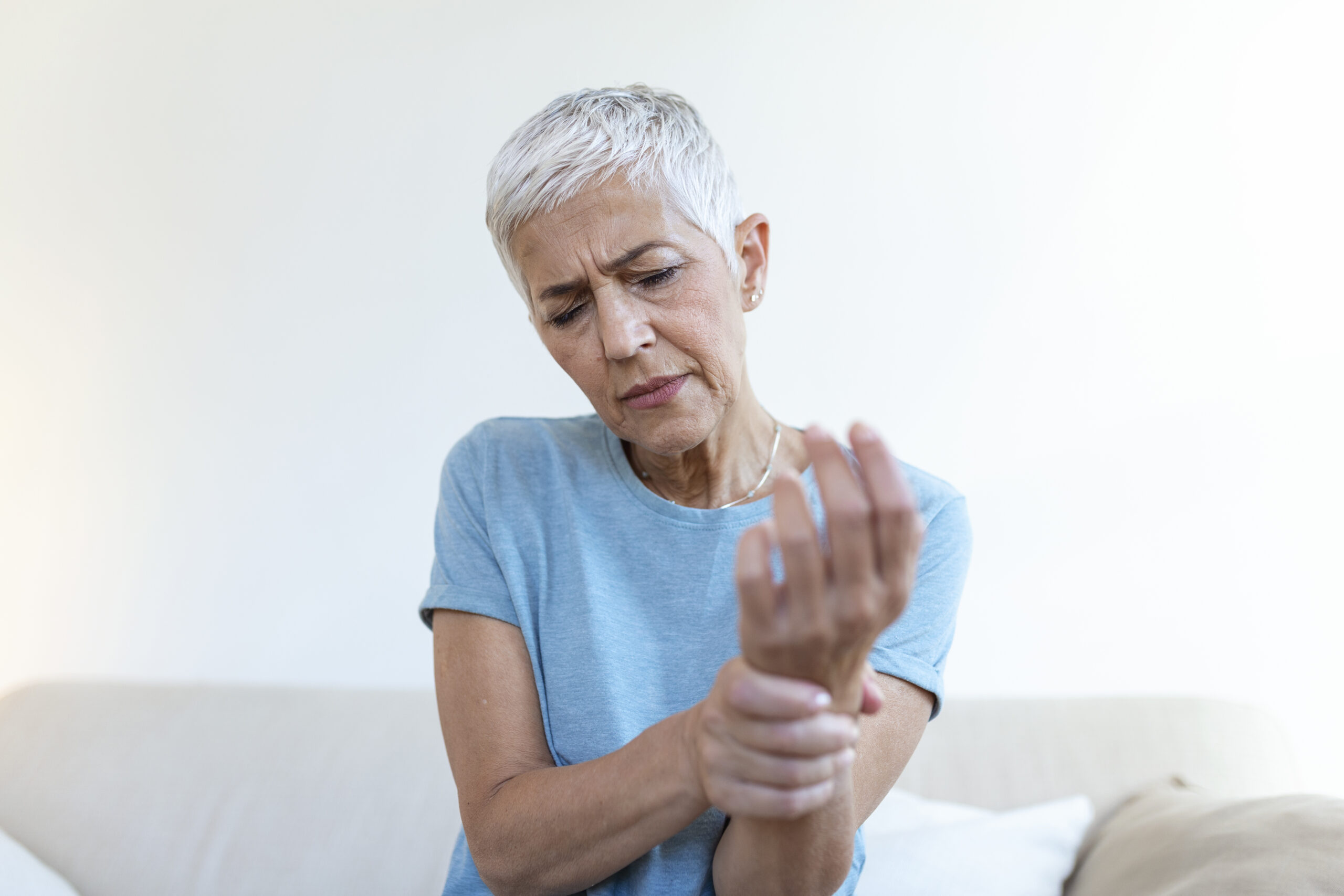What is Laser Therapy in Physiotherapy?

Sue loves spending time with her grandkids. But, lately, she has been struggling with basic movements such as walking in the park or bending down to pick up toys. She tries a few stretches and rubs her stiff neck but in vain. Chronic pain or restricted mobility is a common problem in Canada for various reasons. In most cases, physiotherapy helps. Laser therapy, a physiotherapy modality, has shown effective results in reducing pain in adult patients with musculoskeletal disorders. But, is this the right treatment for you? Let’s find out.
What is Laser Therapy?
Laser stands for Light Amplification by Stimulated Emission of Radiation.
In physiotherapy, laser therapy is a specific treatment approach where a trained therapist applies low-level laser light on the areas of your body that ache or feel stiff. The process is also known as Low-Level Laser Therapy or LLLT.
LLLT is non-invasive. It generates a single wavelength of light and primarily affects the functioning of connective tissue cells. The low-level light accelerates tissue repair and also acts as an anti-inflammatory agent. It is effective in treating a wide range of musculoskeletal disorders among people of various ages.
Common myths regarding laser therapy
Burns or feels painful
LLLT uses low-intensity light that penetrates the skin without emitting heat or causing discomfort.
Instant results
LLLT works cumulatively. While some may find relief after the first session, others may need multiple sessions to feel completely better.
Relieves pain only
Low-level laser therapy reduces inflammation, improves circulation, boosts healing and promotes cell regeneration as well.
Caters to only athletes or serious injuries
Anyone recovering from chronic conditions or injuries can benefit from laser therapy, including seniors, desk job workers and athletes.
Also Read: How to Relieve Neck Pain Easily and Effectively?
How Laser Therapy Works in Physiotherapy?
Laser therapy in physiotherapy or LLLT uses specific wavelengths of light (632 to 904 nm) to promote cellular regeneration and tissue healing. The low-intensity light penetrates the skin and interacts with cells without causing thermal damage or side effects.
What’s the science behind laser therapy?
Absorption of the laser light- The therapist detects the affected areas and applies the light on them. Specific molecules within the cells (primarily the mitochondria, which is the cell’s powerhouse of energy) absorb the light particles.
Photobiomodulation- Once the light is absorbed, it triggers a process called photobiomodulation where all the biological processes within the cells are activated.
Cellular responses- Photobiomodulation leads to several benefits such as enhanced blood circulation, reduced swelling, tissue repair and healing.
How Does Laser Therapy Benefit You?
The benefits of laser therapy are related to the cellular responses triggered by the process called photobiomodulation, as discussed above.
Pain Relief- Laser therapy reduces pain by stimulating cellular repair and reducing inflammation. The light source treatment blocks pain signals and reduces nerve sensitivity, reducing chronic and acute pain.
Improved Blood Flow– LLLT facilitates the flow of nutrients and oxygen to injured cells.
Increased ATP Production-
Reduced Inflammation- Laser therapy controls swelling and promotes faster recovery.
Better mobility- The laser treatment helps regain movement in stiff or injured joints.
Post-surgical rehabilitation- Laser therapy reduces scar tissue formation and promotes faster healing.
All in all, laser therapy is used in physiotherapy to treat a wide range of musculoskeletal disorders that cause pain, limited mobility and discomfort. It is effective in treating conditions like arthritis and nerve pain.
Which Conditions are Treated by Laser Therapy?
Laser therapy is prescribed for various musculoskeletal, neurological, and inflammatory conditions. Here are some of the most common ones:
Pain and inflammatory conditions
- Arthritis
- Osteoarthritis
- Lower back pain
- Fibromyalgia
- Neck & shoulder pain
Sports & overuse injuries
- Sprains & strains
- Tendinitis
- Tennis elbow
- Golfer’s elbow
- Plantar fasciitis
Nerve & neurological disorders
- Sciatica
- Carpal tunnel syndrome
- Neuropathy
Post-surgical & chronic conditions
- Healing after surgery
- Would healing
- Ulcers
- Frozen shoulder
Laser therapy is useful in treating and managing a wide range of conditions. However, the physiotherapist is the right person to determine if the laser is the right treatment for your pain and discomfort. If you are in pain or facing movement difficulties, consult a physiotherapist near you to know the right treatment for your specific condition.
Also Read: 10 Physical Therapy Stretches You Can Do At Office
What to Expect During a Laser Therapy Session?
Describe a typical laser therapy session:
- Preparation (assessment, explanation)
- Application of the laser device
- Duration of the treatment
- Sensation (painless, some may feel mild warmth)
Emphasize the non-invasive and comfortable nature of the treatment.
A trained physiotherapist is most likely to assess your symptoms and let you know if laser therapy is the right treatment for you. Here’s what you can typically expect during a laser therapy session in Brampton.
Injury assessment and patient education
The therapist examines your injuries to understand their underlying causes and severity. If laser therapy seems suitable for treatment, the therapist explains how it works so you know what to expect from the sessions.
Preparation
They detect and clean the areas where the laser light is to be applied.
Laser light application
The physiotherapists use a handheld device to target the laser at the affected area. They may move the device gently or hold it over the area. The technique depends on the type of laser used and the condition that is being treated.
Post-session care
You can get back to your daily life activities right after the sessions. Your physiotherapist may recommend a series of home exercises or lifestyle changes for long-term relief.
Is Laser Therapy Right For Me?
Laser therapy benefits everyone irrespective of their age or fitness level. The main goal of laser therapy in physiotherapy is to trigger the body’s natural healing system. Whether you are a desk job worker suffering from lower back pain or a senior adult with chronic knee pain, laser therapy can be an effective pain-relieving treatment option.
Laser therapy is effective in treating musculoskeletal disorders that cause pain and movement difficulties. There are some exceptions, however, where laser therapy can have side effects such as if the patient is pregnant or they have a certain medical condition.
Note: It is recommended to talk to a registered physiotherapist about your injuries and symptoms to know if laser therapy is right for you.
Finding a Qualified Laser Therapist in Brampton
A qualified and experienced laser therapist can make all the difference in your treatment. Take your time and do your research thoroughly to find a licensed physiotherapist or certified laser therapist near your location. The professional should have experience in low-level laser therapy. Check for patient reviews to understand the quality of work done by the therapist. You can also ask about their expertise, certifications and treatment plans by calling the trusted physiotherapy clinics in Brampton, such as Physiotherapy First, directly.
Blog Categories
- Acupuncture Treatment (10)
- Ankle Sprain (1)
- Arthritis Treatment (1)
- Back Pain (23)
- Chiropractic Care (38)
- Tennis Elbow (1)
- Chronic Pain (5)
- COVID-19 (1)
- Custom Orthotics (6)
- Dizziness (4)
- Exercises (12)
- Foot Orthotics (6)
- Hamstring Stretches (2)
- Info Articles (3)
- Kids Injury (1)
- Laser Therapy (4)
- Massage Therapy (21)
- Neck Pain (16)
- Orthopedic (1)
- Osteoarthritis (5)
- Osteopathy (3)
- Pain Management (17)
- Physiotherapy Benefits (44)
- Physiotherapy Clinic (6)
- Physiotherapy Exercises (12)
- Physiotherapy Tips (25)
- Physiotherapy Treatment (100)
- Rotator Cuff (2)
- Shin Splints (1)
- Shoulder (2)
- Spine (4)
- Sports Physiotherapy (1)
- Uncategorized (1)
- Vestibular Physiotherapy (2)
- Work From Home (2)


